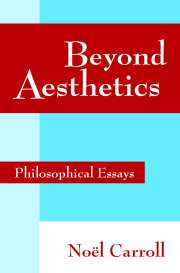Book contents
- Frontmatter
- Contents
- Foreword by Peter Kivy
- Introduction
- PART I BEYOND AESTHETICS
- Art and Interaction
- Beauty and the Genealogy of Art Theory
- Four Concepts of Aesthetic Experience
- PART II ART, HISTORY, AND NARRATIVE
- PART III INTERPRETATION AND INTENTION
- PART IV ART, EMOTION, AND MORTALITY
- PART V ALTERNATIVE TOPICS
- Notes
- Index
Four Concepts of Aesthetic Experience
Published online by Cambridge University Press: 19 January 2010
- Frontmatter
- Contents
- Foreword by Peter Kivy
- Introduction
- PART I BEYOND AESTHETICS
- Art and Interaction
- Beauty and the Genealogy of Art Theory
- Four Concepts of Aesthetic Experience
- PART II ART, HISTORY, AND NARRATIVE
- PART III INTERPRETATION AND INTENTION
- PART IV ART, EMOTION, AND MORTALITY
- PART V ALTERNATIVE TOPICS
- Notes
- Index
Summary
INTRODUCTION
A salient feature of critical practice over the last three decades has been an almost exclusive emphasis on interpretation as the primary mode of the analysis of artworks. Roughly put, the output of such analyses is a message – a set of propositions that the artwork is said to imply or to entertain, or a conceptual schema (e.g., an interpretation may disclose that in the world of a fiction women are all sorted into the categories of madonnas versus whores). These messages, then, are often further evaluated in terms of whether they are progressive or reactionary politically. This approach to criticism, moreover, contrasts with alternative views, such as the notion that what a critic does is to point to features of an artwork in order to elicit a certain kind of experience from the audience.
For instance, the critic points to one part of a painting and then to another, foregrounding similarities, in order to enable the viewer to experience the unity of the painting; or the critic describes the dancer's movement in such a way that on subsequent evenings viewers are able to perceive its qualities of lightness or airiness. Whereas the output of interpretive criticism is a message, the output of what we might call demonstrative criticism is, ideally, the promotion of a certain kind of experience – what is generally called an aesthetic experience – in the audience.
The point of demonstrative criticism is to call attention to the variables that make aesthetic experiences possible. The idea is that by encouraging audiences to dwell on certain features of the work in a certain way, audiences will undergo the relevant experiences.
- Type
- Chapter
- Information
- Beyond AestheticsPhilosophical Essays, pp. 41 - 62Publisher: Cambridge University PressPrint publication year: 2001
- 6
- Cited by



